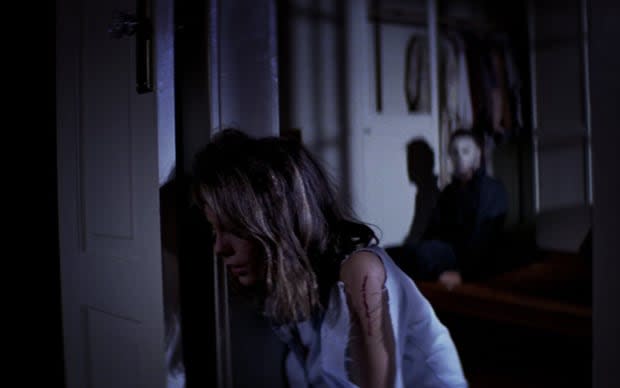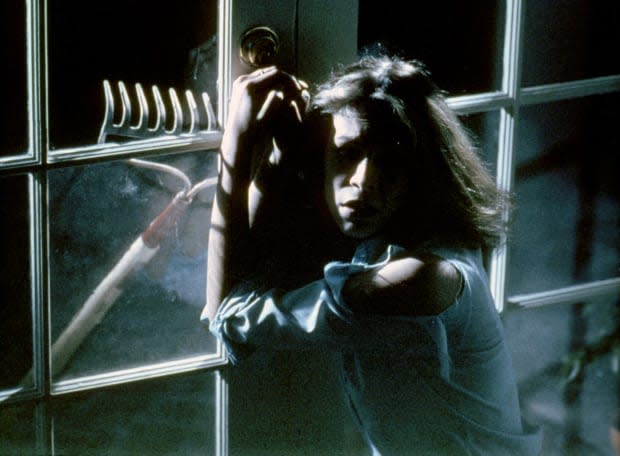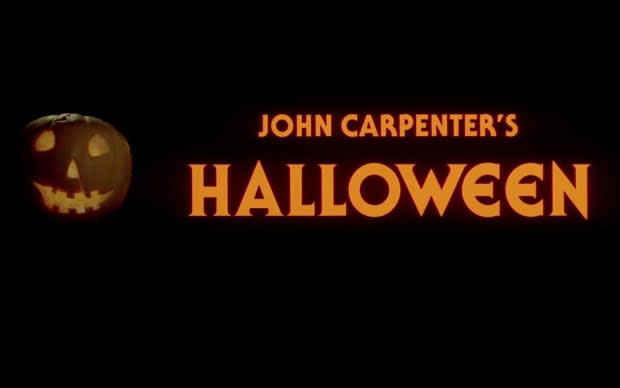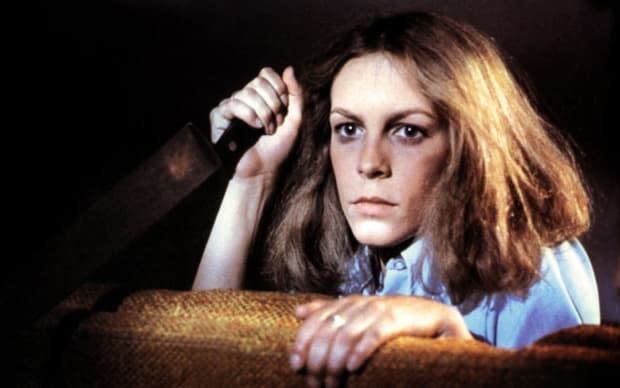John Carpenter's 1978 'Halloween' Is One of the Best, Scariest Horror Movies of All Time—Here's Why
- Oops!Something went wrong.Please try again later.
- Oops!Something went wrong.Please try again later.
- Oops!Something went wrong.Please try again later.
- Oops!Something went wrong.Please try again later.

There are so many great and scary horror movies out there you can watch to get in the Halloween spirit, but there is only one Halloween. Upon its release in 1978, John Carpenter's nerve-frying thriller became the most successful independent movie of all time, setting the bar for modern horror while influencing young filmmakers for generations to come.
Shot in just 20 days on a $325,000 budget in Southern California, the scare-fest set in Haddonfield, Illinois, about white mask-sporting psychopath Michael Myers, who stalks and terrorizes three young babysitters on Halloween night, is now a TV staple. It continues to play to sold-out audiences at midnight showings across the country.
Made with real artistry and considerable taste—funny, exciting and above all terrifying, the first Halloween movie thrills us year after year. Its reputation among fans and critics has only grown.
Prepare for "theater of the mind." Here are seven key reasons why John Carpenter's first Halloween movie is one of the most beloved horror movies of all time.

Compass International Pictures
Halloween is in love with the art of filmmaking, and it doesn't disrespect women.
Halloween is sometimes credited as the first slasher movie. That title more likely belongs to either Alfred Hitchcock‘s Psycho or Michael Powell‘s Peeping Tom, both of which were released in 1960—and Tobe Hooper‘s The Texas Chain Saw Massacre and Bob Clark‘s Black Christmas (both 1974) followed a similar formula. That's not even mentioning the Italian giallo movement.
Halloween is, unquestionably, the film that popularized the subgenre. With a production budget of just over $300,000 (shoestring even in 1978), Halloween was wildfire at the box office, grossing over $70 million—the most profitable independent film of all time until 1999’s The Blair Witch Project. In the wake of Halloween‘s success, the slasher became the most prominent brand of horror film on the market, which it remained until roughly around the turn of the century.

Compass International Pictures
It’s no secret that the horror genre—in particular slasher films—has a sometimes-spotty reputation for its depiction of women. And this is not wholly undeserved: so many of the legions of 1980’s slasher films released after Halloween, with titles like Silent Scream, Don’t Answer the Phone! and I Spit on Your Grave, present us with unsympathetic, underwritten and objectified female characters who are little more than cannon fodder. Even more problematic is that so many of the countless far-less-well-remembered-than Halloween slasher movies out there seem to suggest that the audience sympathizes with the killer and not the victims.
This isn’t the case with Halloween. While Carpenter wrote much of the screenplay himself, producer Debra Hill wrote the dialogue between the three female high school-aged leads (Jamie Lee Curtis as Laurie, Nancy Loomis as Annie and P.J. Soles as Lynda) to give it authenticity. They’re funny, they small-talk about boys and they’re believable. Also, despite Carpenter’s use of the killer’s POV in the opening shot, Michael is never more than an enigma and our sympathies are always with the people he’s stalking.

Getty Images
Fans and critics judge Halloween solely by the movie that it is, not by the countless imitators it inspired. Comparing Halloween to more cynical, far less artistic fare like Friday the 13th doesn’t even seem fair. Halloween is simply a better film than nearly all other slashers, made with the kind of tact and artistic flourishes the copycats wouldn’t even attempt.
Related: Halloween Cast: Where Are They Now?
Halloween is highly influential to this day.
Carpenter, 30 at the time, made Halloween on a shoestring budget and worked with a small, young crew. One of the things horror fans love about this movie is that it really feels like a bunch of kids went outside with their equipment and made the scariest movie they could. To be clear: a bunch of highly skilled and gifted kids. A masterclass in slow-burn suspense, the film is a stunning display of raw, young talent. Cinematographer Dean Cundey would go on to become one of the most sought-after talents in his field for his stunning widescreen ingenuity here.
Halloween‘s low budget shows here and there if you're really looking for it, or watching for the millionth time: the film was shot in Southern California and had to pass for middle America in autumn, so the crew hand-painted several trash bags full of leaves, throwing them in front of the camera before every outdoor shot, then gathering them back up for the next take. Also, a few palm trees are visible on occasion. But this only adds to the appeal. This thriller feels handmade, a breath of low-fi fresh air.

Compass International Pictures
While the slasher formula has been duplicated for decades, Carpenter’s distinct style continues to inspire young filmmakers, perhaps in modern times more than ever. The attention-grabbing synth music and retro feel of Netflix’s Stranger Things are heavily inspired by Carpenter. The cinematography in 2016’s surprise smash Don’t Breathe calls to mind Halloween director of photography Dean Cundey‘s highly effective, chilling and sometimes startling use of widescreen space. 2015’s It Follows, a terrific film in its own right, wouldn’t exist without Halloween; writer/director David Robert Mitchell fully adopted Carpenter’s audiovisual aesthetic, but made it so fresh and scary that it felt like a sincere homage.
This is just scratching the surface; the touch of early Carpenter is everywhere these days. So why are we seeing such a resurgence in popularity and influence of vintage Carpenter right now? We live in the age of the $250 million blockbuster—or in the pandemic era, possibly in the wake of it. While several of these massive films turn out quite good or even great, others are overstuffed. There’s something infinitely appealing and resonant today about the way John Carpenter was able to get maximum impact out of minimal ingredients, and big excitement from small-scale and stripped-down stories. Below is a video in which esteemed BBC film critic Mark Kermode says he sees the early work of Carpenter, in particular Halloween, as “Year Zero” for up-and-coming filmmakers.
The element of mystery
One of the greatest strengths of the original Halloween is how much goes unexplained. Michael Myers is evil. He is a psychopath. He kills people, and on this night, he's set his sights on an ordinary American town. That's it. We know nothing else about him, we barely even see his face, and that's what makes him frightening. If anything, one can read Halloween as simply a metaphor for the unfortunate truth that there is evil in the world, and sometimes bad things happen to good people, but there's really no subtext here. What sets Halloween apart from other films of its ilk is how extraordinarily well crafted and entertaining it is.

Compass International Pictures
Related: The Wizard of Oz Is the World's Favorite Movie. Here's Why.
The music
Oh, the music! John Carpenter's father, a music teacher, taught him how to play 5/4 time on a set of bongos when he was a child. That rhythm became Carpenter's signature musical composition—perhaps the most famous horror score of all time apart from John Williams's work on Jaws. Like the film itself, Halloween's theme music is stripped-down, gorgeous, primal, tantalizing— and it gets a little more ominous as it goes along. It's impossible to get it out of your head, too.
Below, check out Trent Reznor and Atticus Ross's atmospheric, hard-rocking and windchime-tastic new take on Carpenter's iconic theme. Go for a jog and listen to this on a cold autumn night, and you'll never forget it.
Jamie Lee Curtis as Laurie Strode
There are two qualities about Jamie Lee Curtis as an actress that stand out the most: her intelligence and her likability. Curtis is one of the smartest people in the entertainment industry, and no matter what role she's playing, we always root for her. In her big screen debut, Curtis was perfectly cast as the clever and good-natured Laurie Strode, the quintessential "final girl."
Laurie Strode is recognizable and relatable; she's someone you'd want to be friends with in high school. She is strong and resourceful. The pleasant surprise we get when the mild-mannered babysitter fights back, frequently getting the high ground, is one the many reasons this movie is so insanely fun to watch.
Curtis' huge appeal as a screen presence caught on quick, and Halloween catapulted her to the A-list and gave her a film career. She is as much a vital and fondly remembered part of Halloween lore as the film's iconic villain. When it was announced she would return for David Gordon Green's 2018 soft reboot, fans rejoiced.

Compass International Pictures
6. Good old-fashioned suspense over buckets of blood

Halloween earned its reputation as one of the most merciless and frightening of all thrillers ever with virtually no graphic violence onscreen. It's not that gore is inherently a bad thing in a horror film, not at all; gore for the sake of gore is just nowhere near as exciting or impressive as genuine suspense and atmosphere. The myriad slasher imitators that followed including Halloween's direct sequels relied heavily on bloodshed. The mostly well-received, hugely lucrative reboot would have been a stronger film if it had harkened back to the quiet, nimble and inventive thrills that made the 1978 picture so special. Halloween Kills, unfortunately, took the series back into the gutter.
Compare anything in the numbing, repetitive Kills to Halloween's climactic battle of the wits and wills between a masked killer and a teenage girl? That's genuinely thrilling. Or how about that scene in Halloween where a young woman's boyfriend pulls a funny prank on her by appearing in her bedroom doorway wearing a ghost sheet costume—only that’s not actually her boyfriend under there? That is terr-i-fy-ing.

Halloween is the quintessential popcorn horror film—a thrill ride with few equals.
Halloween is a lot of fun, pure and simple. It’s a lot of fun to go into a dark theater to have an experience—to leap into the air and grab the person sitting next to you. John Carpenter wrote the book on contemporary popcorn horror with Halloween, and the film has been copied relentlessly for over four decades, but never improved upon. The American Film Institute has christened Halloween one of the most heart-pounding American films of all time, and in 2006 the Library of Congress added it to the National Film Registry, calling it "uniquely artistic, frightening and a horror film keystone."
In conclusion, here's a glorious YouTube nugget, a video of a 1979 audience's reaction to Halloween's final heart-stopping moments. This was recorded at a movie house in the heart of Hollywood during the film's initial theatrical run. Listen to this screaming, cheering, laughing and gasping. This is why we go to the movies, folks!
Next up, the best, scariest horror movies on Netflix right now.
